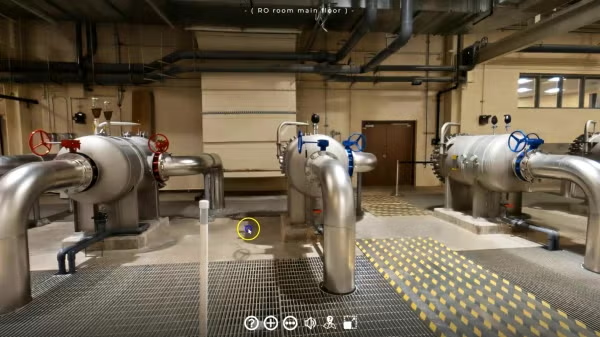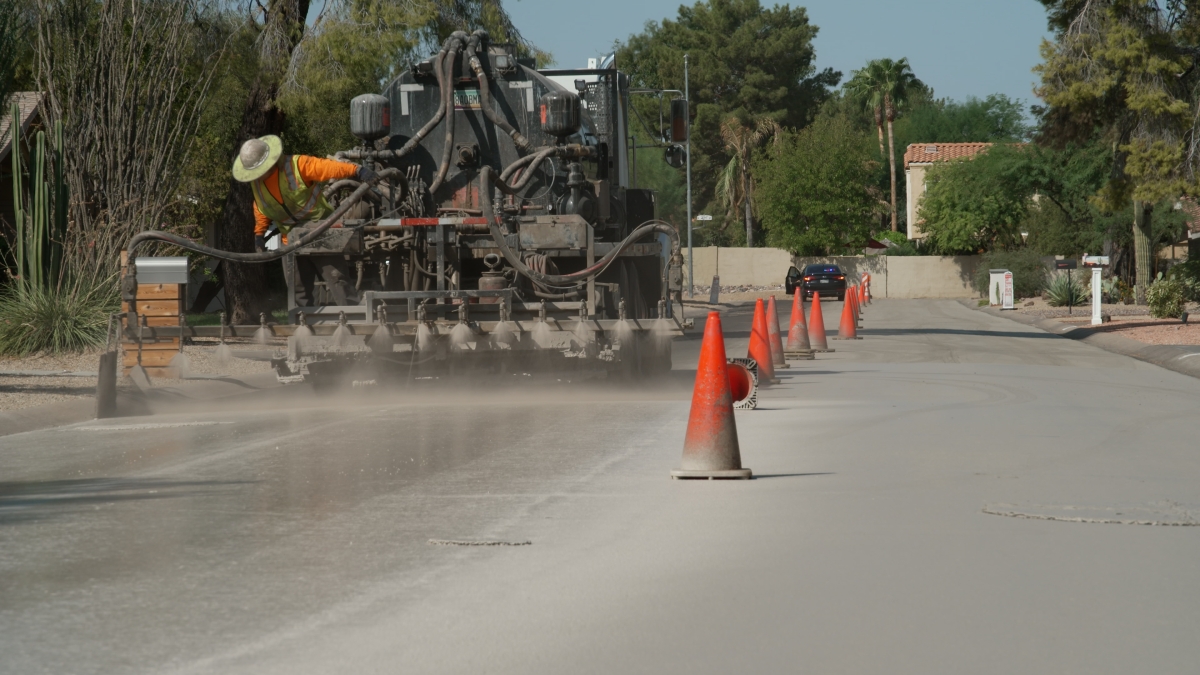Summer’s heat and sun can push the surface temperature of city streets in Phoenix as high as 180 degrees Fahrenheit. Those streets then stay hot long after the sun goes down, radiating their built-up energy back into the night air, making the next morning hotter, in an ongoing cycle.
If you’ve ever owned a black vehicle, you know it gets hotter than a white or silver vehicle when parked in the sun. Scientists at the Lawrence Berkeley National Laboratory found that difference between dark and light-colored vehicles can be 10 degrees Fahrenheit or more.
The same is true for the pavement we drive on. Lighter, more reflective surfaces will stay cooler than darker ones. But could that difference be enough to make an entire neighborhood cooler and more comfortable?
Roadway engineers with the city of Phoenix put a team of Arizona State University researchers to work to answer that question. A yearlong joint study by the city and ASU applied a reflective gray treatment called CoolSeal to 36 miles of neighborhood roads and a parking lot. After months of measurements, sometimes on days as hot as 116 F, the team has some answers.
“Perhaps the most meaningful measurement,” said ASU’s Ariane Middel, “is the mean radiant temperature.”
The scientist’s unique tool to get this value is a garden cart, nicknamed “MaRTy.”
“The cart has meteorological sensors, and we can wheel it from place to measure the heat load that the body experiences from the sun. It’s a value called mean radiant temperature — MRT — and that’s where MaRTy’s name come from.”
Data collection demanded miles of walking pulling MaRTy, driving streets in an SUV loaded with sensors, and sometimes even hanging out of helicopters, and hand-held infrared thermometers.
“Looking specifically at the radiant temperature in the neighborhood, we did vehicle traverses that measured the air temperature distribution, and then we also did helicopter overflights to take surface-temperature photos of those neighborhoods, and compare the cool pavement neighborhoods to the ones with the regular asphalt,” said Middel, an assistant professor in both the School of Geographical Science and Urban Planning, and the School of Arts, Media and Engineering.
Surface temperatures of the roads with the reflective CoolSeal layer stayed cooler than non-treated streets at all times of the day; as much as 10 to 12 degrees cooler at noon, and almost two and a half degrees cooler at sunrise.
The team also took measurements of the air temperatures 6 feet above the surfaces. Here, the differences were not as dramatic. During the daytime, the CoolSeal dropped the air temperature by an average of just 0.3 degrees Fahrenheit. Nighttime temperatures improved a bit more, averaging 0.5 degrees cooler.
A cart outfitted with metrological sensors helped the team measure mean radiant temperature, or the heat load that the body experiences from the sun, in neighborhoods where the cool pavement coating had been applied.
MaRTy’s readings were among the most important in the study. The array of sensors on the carts found the human experience of heat exposure at noon and the afternoon hours was 5.5 degrees Fahrenheit higher due to surface reflectivity, but similar to walking on a typical concrete sidewalk.
“If you’re standing over one of these surfaces on a hot day, you’re still going to be hot if you’re not in the shade,” said Jennifer Vanos, an assistant professor in the School of Sustainability who worked on the study. “So if we really want to be pushing towards true solutions to the heat problems, it's not going to be just paint all the streets white. You’re going to have to really keep thinking about shade, which Phoenix is doing. And then see, how does that interact with the shade, too? Which gets even more complicated than just the open surfaces.”
The city of Phoenix will begin a Phase 2 of the study in the months to come.
More Environment and sustainability

2 ASU faculty elected as AAAS Fellows
Two outstanding Arizona State University faculty spanning the physical sciences, psychological sciences and science policy have been named Fellows of the American Association for the Advancement of…

Homes for songbirds: Protecting Lucy’s warblers in the urban desert
Each spring, tiny Lucy’s warblers, with their soft gray plumage and rusty crown, return to the Arizona desert, flitting through the mesquite branches in search of safe places to nest.But as urban…

Public education project brings new water recycling process to life
A new virtual reality project developed by an interdisciplinary team at Arizona State University has earned the 2025 WateReuse Award for Excellence in Outreach and Education. The national …



